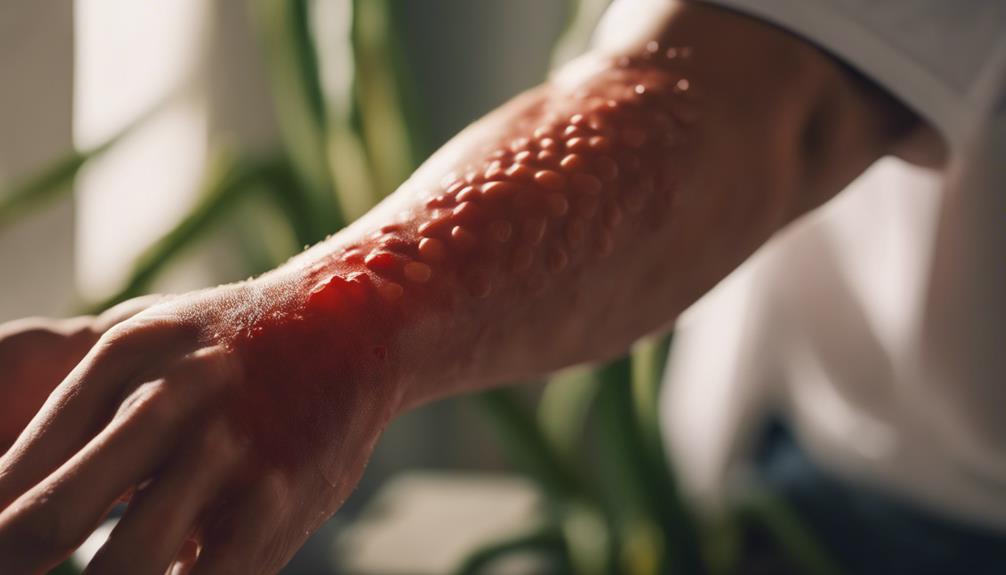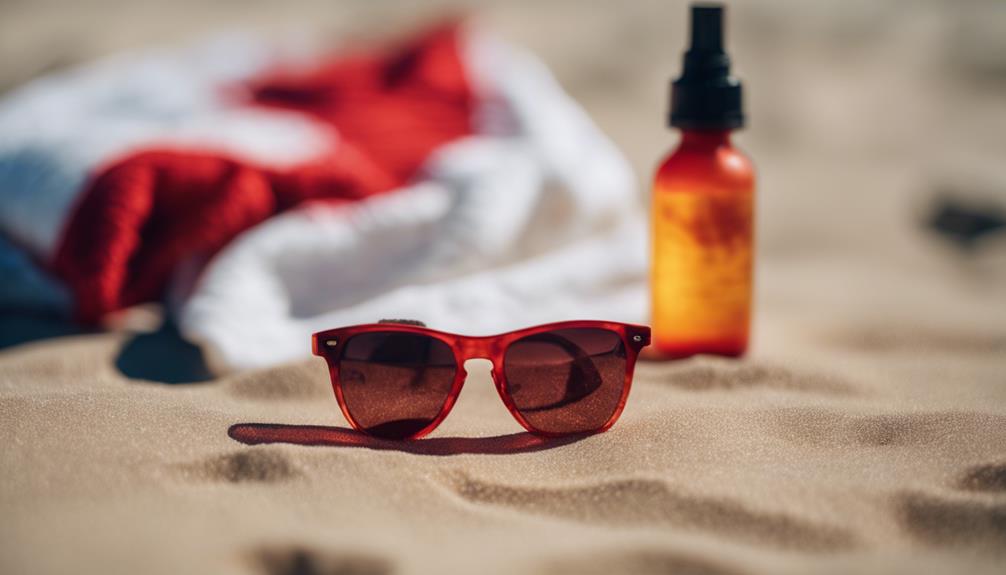If you are experiencing itching after tanning, it is likely due to UV exposure, moisture loss, or an allergic reaction to tanning products. Your skin may become irritated, resulting in dryness and raised bumps. Overexposure can also cause rashes. To relieve the itch, make sure to keep your skin moisturized and consider using fragrance-free lotions. Cool showers and aloe vera can help to soothe inflammation. If the itching continues for several days or if you notice other concerning symptoms, it is advisable to seek professional advice. Wondering how to prevent this discomfort next time? There is much more to explore!
Key Takeaways
- UV radiation exposure can irritate the skin, leading to discomfort and itchiness after tanning sessions.
- Moisture loss from the skin can result in dryness, which often causes itchiness post-tanning.
- Allergic reactions to tanning lotions may trigger redness, rashes, and persistent itching.
- Overexposure to UV rays can cause skin rashes or tanning bed rash, contributing to irritation.
Causes of Itchiness
After tanning, your skin might feel itchy due to irritation from UV radiation and moisture loss. When you expose your skin to UV rays, it can become irritated, leading to discomfort and itchiness. This irritation often signals that your skin is losing moisture, resulting in dryness.
If you're using tanning lotions, be aware that allergic reactions can also trigger itching, redness, or rashes. Overexposure to UV rays can further intensify these issues, potentially causing skin rashes or what's known as tanning bed rash.
It's important to recognize these factors to understand why your skin reacts the way it does after tanning. Taking preventive measures can help minimize itchiness and maintain your skin's health.
Skin Reactions and Symptoms
Experiencing itchiness can often lead to visible skin reactions, such as raised bumps and redness, indicating a tanning bed rash or irritation from UV exposure. You may notice various symptoms that signal your skin's distress:
- Raised Bumps: Small, itchy bumps may develop on the skin's surface.
- Inflammation: Redness and swelling can occur, making the affected area uncomfortable.
- Duration of Symptoms: Monitor how long the rash persists; anything lasting over five days should prompt a doctor's visit.
If you see pus or develop a fever, seek professional help immediately.
Your skin's reactions are your body's way of telling you something's wrong, so listen closely and take action when needed!
Prevention and Care Techniques

To prevent itchiness and irritation from tanning, it's crucial to moisturize your skin before and after each session. This keeps your skin hydrated and minimizes dryness.
Gradually increase your tanning session duration to help your skin build tolerance to UV exposure.
Choose hypoallergenic tanning lotions to reduce the risk of allergic reactions, which can cause redness and itching.
Taking breaks from tanning will also give your skin a chance to recover and prevent irritation.
Always listen to your body; if you notice any signs of discomfort, take action immediately.
Soothing Itchy Skin
Moisturizing your skin can greatly soothe itchiness after tanning, helping to calm irritation and restore hydration. To effectively relieve your discomfort, consider these three steps:
- Apply Aloe Vera: This natural remedy has cooling properties that can reduce inflammation and promote healing.
- Use Fragrance-Free Moisturizers: These are less likely to irritate your already sensitive skin, providing essential hydration without added fragrances.
- Take Cool Showers: Hot water can exacerbate itchiness, so opt for a cool shower to soothe your skin and alleviate discomfort.
Additionally, chilling your moisturizer before application can enhance the cooling effect.
Avoid further UV exposure until your skin heals, allowing it the time it needs to recover.
When to Seek Help

If your itching or rash persists for more than a few days, it's time to seek professional advice. Don't ignore symptoms like excessive scratching, which can lead to infections.
If your rash is accompanied by oozing or discoloration, you should consult a healthcare provider immediately. Home remedies mightn't be enough, and you may need prescription treatments to alleviate your discomfort.
Additionally, if you have a family history of skin cancer, discussing safer tanning options with a professional is essential. Remember, being aware of your skin's reactions is important for effective tanning practices.
Trust your instincts—if something feels off, it's always better to get checked out sooner rather than later. Your skin's health is worth it!
Frequently Asked Questions
Can Tanning Cause Long-Term Skin Damage?
Yes, tanning can cause long-term skin damage. Overexposure to UV rays accelerates aging, leads to wrinkles, and increases your risk of skin cancer. Protect your skin by using sunscreen and limiting tanning sessions.
How Does Skin Type Affect Tanning Itchiness?
Your skin type greatly influences how you react to tanning. If you have sensitive skin, you're more likely to experience itchiness and irritation. Always assess your skin's tolerance and adjust your tanning practices accordingly.
Are There Safe Tanning Alternatives Available?
Yes, there are safe tanning alternatives available. You can try self-tanners, bronzers, or spray tans. These options provide a sun-kissed look without harmful UV exposure, helping you achieve a golden glow safely and effectively.
Does Diet Influence Skin Reactions After Tanning?
You might think your diet's just about taste, but it really impacts your skin's reaction post-tanning. Consuming antioxidants and healthy fats can boost skin resilience, helping you recover better from tanning sessions.
Can Medications Affect Sensitivity to Tanning?
Yes, certain medications can increase your skin's sensitivity to UV rays. If you're on medications like antibiotics or antihistamines, it's essential to consult your doctor about potential effects on tanning and skin reactions.
How Can Tanning Bed Overuse Cause Itching?
Overusing tanning beds can lead to uncomfortable itching, which is one of the tanning bed warning signs to look out for. The UV radiation from tanning beds can dry out the skin, causing irritation and itching. It is important to be aware of these warning signs and avoid excessive tanning bed use.
Can Using a Moisturizer Cause Itchiness While Tanning?
When it comes to the moisturizer and tanning relationship, it is possible for using a moisturizer to cause itchiness while tanning. Some moisturizers can contain ingredients that may react with the skin when exposed to UV rays, leading to irritation and itchiness. It’s important to choose a moisturizer that is specifically designed for use during tanning to avoid any discomfort.
Conclusion
After a tanning session, it's not uncommon to feel that annoying itch, often stemming from dryness, product reactions, or overexposure.
Coincidentally, as you find ways to soothe your skin, you might discover new care techniques that enhance your overall tanning experience.
By prioritizing hydration and choosing the right products, you can enjoy your sun-kissed glow without discomfort.
Remember, your skin deserves extra love and attention, so take those steps to keep it happy and healthy.










